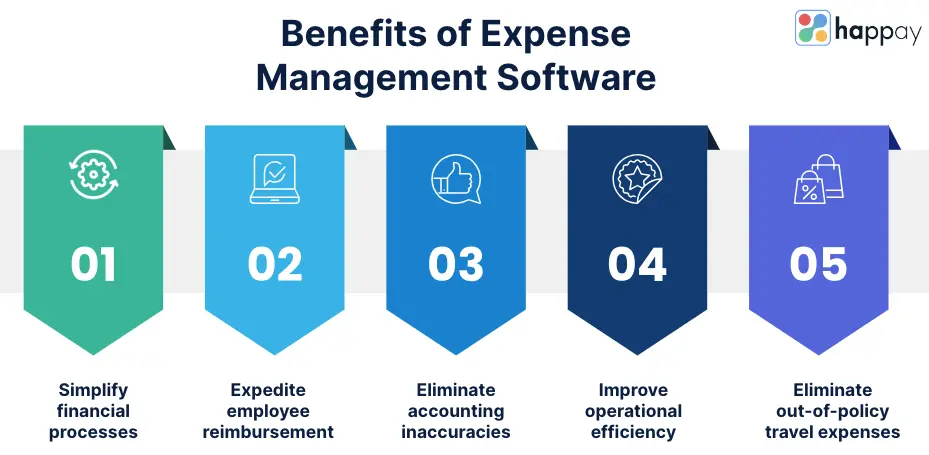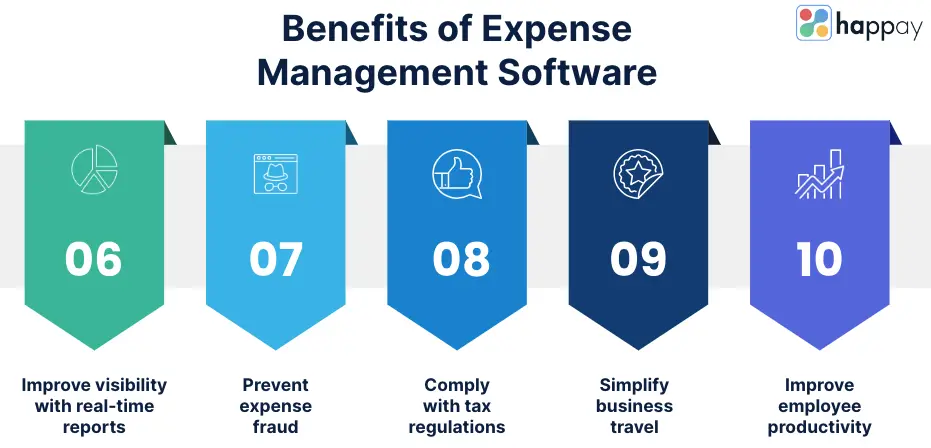Last Updated on November 28, 2025
Did you know that 60% of enterprises still use spreadsheets, paper, and manual processes for expense management? They struggle with the complexity of manual processes and spend more time closing books and reconciling cards. If these issues are worsening your expense management headaches, it’s time to embrace the benefits of expense management software.
Related reads: Expense Management Tips
Top 10 Benefits of expense management software
Enterprises rely on expense management software for financial planning, expense reporting, and reimbursements. The result is improved productivity, cost savings, employee satisfaction, and compliance.
1. Simplify processes
With online expense reporting software, you can say goodbye to the hassle of printing and submitting paper copies of invoices and receipts. Expense management automation enables you to route business invoices for automatic approval, accounts payable reporting, and reimbursements. In turn, accounting teams save valuable time and money that they’d otherwise spend on flagging out-of-policy expenses, processing reports, and approving reports for payment.
2. Expedite employee reimbursement
Automated expense reimbursement makes it effortless for employees to submit expense reports and paperwork on time. This process allows managers to review and approve claims as they come in. Expense reimbursement automation also ensures employee satisfaction by eliminating unnecessary errors and delays, leaving no room for frustration.
Related reads: Expense Reimbursement
3. Eliminate accounting inaccuracies
The days of finance and accounting teams making data entry errors due to transcribing manual reports to spreadsheets are now over. Earlier, these manual errors resulted in reimbursement delays.
Today, expense management software solutions eliminate manual data capturing, directly pulling data from credit card statements, bank accounts, and employee receipts. Employees can also use optical character recognition (OCR) to scan, capture, and submit reports. This automated data capturing ensures accounting accuracy.
Expense management systems also integrate with accounting systems and corporate travel management solutions to eliminate duplicate entries, prevent overpayment, find overdue payments, and spot accounting errors.
4. Improve operational efficiency
Enterprises billing expenses to customers struggle with timely expense reporting and approval, negatively impacting organizational cash flow. Expense management solutions enable these businesses to capture expenses automatically, thanks to their integration with enterprise resource planning (ERP) software, time tracking solutions, and project management systems. As a result, employees can prioritize value-added tasks and save time while improving organizational financial performance.
Suggested reading: Tactics for Smart Expense Management in Business

5. Eliminate out-of-policy travel expenses
Employees may not always be aware of the latest expense policy changes, making expense policy reinforcement another crucial pain point for enterprises. Automated expense management solutions allow them to categorize and identify employee expenses accurately. These systems also aid businesses in complying with local and state tax regulations while ensuring that all expenses align with the company’s travel and expense policy.
6. Improve visibility with real-time reports
Enterprise business managers also struggle with confident decision-making without expense management software. They may need to analyze employee expense claims, create budgets, or estimate return on investment, which can be tricky with manual reporting.
With expense management software, they can quickly check crucial metrics like expense per employee, per category, and average report approval time. This granular data provides businesses with improved financial visibility, which is indispensable for informed decision-making.
Also, consider following expense management best practices to spot high-spending employees, analyze expense trends, and enforce expense policy for organizational growth.
7. Prevent expense fraud
Did you know most organizations lose about 5% of their annual revenue to expense fraud? Although this is a seemingly low number, it significantly impacts your organization’s financials during turbulent times.
Expense fraud or expense fiddling is a type of scheme in which employees manipulate or falsify expenses to avoid paying out of their pockets and instead claim reimbursements. These frauds occur for various reasons, including outdated policies and loopholes in the expense reporting process. While finance teams may not always be able to catch duplicate entries, it’s best to use expense management software to prevent expense fraud.
Expense management automation tools feature built-in mechanisms to spot fraudulent and duplicate claims. As a result, you don’t have to chase employees for over-paid expenses or deal with potential troubles during financial audits. Businesses can also provide employees with prepaid corporate credit cards to avoid expense fraud.
Suggested reading: Best wireless expense management software
8. Comply with tax regulations and policies
Tracking employee expenses can be challenging, which is why enterprises must use expense management software to verify expenses against predefined rules, including spending limits, eligible expense categories, and documentation requirements.
Consequently, organizations can create and maintain a comprehensive expense audit trail instead of paper-based receipts and spreadsheets. This digital audit trail is crucial for identifying non-compliant expenses or expense accounting violations. Businesses also use these digital documents to adhere to regulations and policies set by external regulators and internal compliance teams.
9. Simplify business travel
Expense management software also simplifies the entire business travel and expense management process for employees and organizations. An expense management mobile application allows employees to submit their expense reports without hassle swiftly.
Managers can also use the mobile app to review and approve business trip reimbursement requests. This results in efficient travel expense management and provides employees with complete peace of mind during their trips.
Suggested reading: Best Way to Manage Expenses in an Enterprise

10. Improve employee productivity
Expense management systems simplify expense data reporting and enable enterprises to reduce workload. These solutions eliminate the need for employees to carry paper receipts or wait for finance teams to approve reimbursements.
Employees can scan and submit receipts using the OCR functionality of expense management mobile applications. Finance teams can then accept or reject reports based on whether they meet the company policy. Expense management automation also streamlines financial systems, improving financial management and employee productivity.
Are you an enterprise seeking these advantages with an expense management platform? Happay is the right choice for organizations aiming to simplify travel and expense management reporting and analytics.
Happay: Expense management software
As an all-in-one expense management software, Happay solves enterprises’ corporate travel, payment, and expense-related challenges effectivelty. Check out how Happay helps you solve expense management pain points.
- Xpendite automatically captures financial data from over six sources, including cards, SMS, physical bills, and cabs.
- SmartAudit ensures 100% policy compliance by identifying policy violations, overclaimed expenses, and duplicate invoices.
- ApprovNow provides employees, approvers, and finance teams with real-time approval alerts, ensuring 100% on-time approvals.
- DeepAnalyze offers real-time insights and lets you create custom reports for efficient financial decision-making.
- FileEx ensures an easy filing process for employees, besides letting you send automated reminders for expense filing.
- Reimburse features an intuitive dashboard so organizations can easily ensure auto-reimbursements and bulk reimbursements.
- GST module allows organizations to fetch GST details automatically, capture vendor GSTIN, file GSTR1, and verify GSTR-2.
Whether you’re looking to optimize organizational spending, achieve policy compliance, or eliminate expense fraud, Happay is the right choice for you. Schedule a demo today to see Happay in action.
Suggested Reads: Expense management software in India
Conclusion
Managing expenses manually, whether it’s capturing paper receipts or reimbursing expenses, is frustrating and time-consuming. Using expense management software eliminates paper-heavy administrative processes and allows for better oversight of employee expenses. Moreover, organizations can reduce reimbursement time lag and boost employee experience with expense management automation.
FAQs
Integrating expense management software into a business workflow enables organizations to:
Simplify processes
Expedite employee reimbursement
Eliminate accounting errors
Boost operational efficiency
Minimize out-of-policy expenses
Prevent expense fraud
Comply with tax regulations
Simply business travel
Boost employee productivity
Expense management software allows organizations to spot overspending, overclaimed expenses, duplicate invoices, and out-of-policy expenses. Eliminating all these helps an enterprise to remove wasteful expenses and improve savings.
Expense management software integrates with accounting systems, project management tools, and time-tracking solutions to automate the entire process of capturing, verifying, and reimbursing financial data. As a result, it becomes easier to maintain accurate financial records without manual intervention.
Expense management software improves employee compliance by rejecting out-of-policy expense claims, duplicate invoices, and fraudulent expense activities. Moreover, these solutions make it easier for organizations to create and maintain digital audit trails crucial for complying with internal and external regulatory policies.
Expense tracking and management tools enable organizations to digitally capture and verify receipts, categorize expenses, and generate comprehensive reports. This digital data lets finance teams get real-time visibility into metrics that matter most, including expense trends, expense per employee, and average report approval time.










Discussion about this post